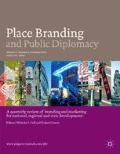Abstract
In the province of Ontario, Canada, tremendous attention is being paid to place branding at a community level, with communities adopting it as a policy tool to promote economic development. In fact, the bulk of the communities have developed or are in the process of developing some form of brand that is communicated to the outside world. A strongly emphasized component of branding in the province is visual identity, represented through logos. This study examines the extent of branding in the province of Ontario, Canada, through a comprehensive content analysis of community brand images, presented visually through logos. This analysis affirms that place branding is occurring in Ontario in all types of communities, but the size and type of community affect the imagery typically utilized. While there is a tendency among all communities to rely on tourism as their main place brand, cities are more likely to incorporate industry into their visual identity, while townships incorporate agriculture. A key finding in this research is that the visual identities represented in Ontario’s communities do not necessarily align with the economic realities of the province. Thus, the results of this study suggest that Ontario’s communities may not be reaping the expected benefits in their place branding efforts. The article recommends that communities need to consider re-examining their branding strategy to maximize the opportunity for future economic development while demonstrating fiscal responsibility and sound public governance.
Similar content being viewed by others
References
Agresti, A. (2013) Categorical Data Analysis. 3rd edn. Hoboken, NJ: Wiley.
Allen, G. (2007) Place branding: New tools for economic development. Design Management Review 18 (2): 60–69.
Anholt, S. (2005) Some important distinctions in place branding. Place Branding 2 (1): 116–121.
Anholt, S. (2006) The Anholt-GMI city brands index: How the world sees the world’s cities. Place Branding 2 (1): 18–31.
Anholt, S. (2007) Competitive Identity. London: Palgrave Macmillan.
Anholt, S. (2008) Place branding: Is it marketing or isn’t it? Place Branding and Public Diplomacy 4 (1): 1–6.
Anholt, S. (2009) Should place brands be simple? Place Branding and Public Diplomacy 5 (2): 91–96.
Arku, G. (2014) Competition and cooperation in economic development: Examining the perceptions of city officials in Ontario. Canada. Journal of Urban Affairs 36 (1): 99–118.
Ashworth, G. and Voogd, H. (1994) Marketing and place promotion. In: J. Gold and S. Ward (eds.) Place Promotion: The Use of Publicity and Marketing to Sell Towns and Regions. Chichester, UK: John Wiley and Sons.
Avraham, E. (2004) Media strategies for improving an unfavorable city image. Cities 21 (6): 471–479.
Balmer, J.M.T. and Soenen, G.B. (1999) The acid test of corporate identity managementTM. Journal of Marketing Management 15 (1–3): 69–92.
Bennett, P.D. (1998) Dictionary of Marketing Terms. Chicago, IL: The American Marketing Association.
Bergqvist, R. (2009) Place marketing in a logistics context: A Swedish case study and discourse. Place Branding and Public Diplomacy 5 (1): 54–66.
Blakely, E.J. and Green Leigh, N. (2010) Planning Local Economic Development: Theory and Practice. 4th edn. Washington: Sage.
Bourne, L., Britton, J. and Leslie, D. (2010) The greater Toronto region: The challenges of economic restructuring, social diversity, and globalization. In: L. Bourne, T. Hutton, R Shearmur and J. Simmons (eds.) The Canadian Urban Region: Trajectories of Growth and Change. Toronto, ON: Oxford University Press.
City of Brampton. (2012) Creating a Breakthrough Brand For Brampton Economic Development. City of Brampton.
Danesi, M. (2006) Brands. New York: Routledge.
De Chernatony, L. and Riley, F. (1998) Defining a ‘brand’: Beyond the literature with experts’ interpretations. Journal of Marketing Management 14 (5): 417–443.
De Lencastre, P. and Côrte-Real, A. (2010) One, two, three: A practical brand anatomy. Journal of Brand Management 17 (6): 399–412.
Dinnie, K. (2011) City Branding: Theory and Case. Basingstoke, UK: Palgrave Macmillan.
Fan, Y. (2006) Branding the nation: What is being branding? Journal of Vacation Marketing 12 (1): 5–14.
Fan, Y. (2008) Self perception and significant others: A conceptual framework for nation image. The Proceedings of the Sixth Asia Academy of Management Conference; December, Taipei, pp. 14–16.
Florek, M., Insch, A. and Gnoth, J. (2008) The trademark protection of country brands: Insights from New Zealand. Journal of Place Management and Development 1 (3): 292–306.
Florida, R. (2012) Rise of the Creative Class Revisited: 10th Anniversary Edition. New York: Basic Books.
Gertler, M.S. (1990) Economic development. In: R.A. Loreto and T. Price (eds.) Urban policy issues: Canadian perspectives. Toronto: McClelland and Stewart.
Gertler, M.S. (2002) Competing on Creativity: Placing Ontario’s Cities in North American Context. Toronto, ON: A report prepared for the Ontario Ministry of Enterprise, Opportunity and Innovation and the Institute for Competitiveness and Prosperity.
Gnoth, J. (2002) Leveraging export brands through a tourism destination brand. Journal of Brand Management 9 (4/5): 262–280.
Hankinson, G. (2004) Relational network brands: Towards a conceptual model of place brands. Journal of Vacationing Marketing 10 (2): 109–121.
Hanna, S. and Rowley, J. (2008) An analysis of terminology use in place branding. Place Branding and Public Diplomacy 4 (1): 61–75.
Hansen, R.H. (2010) The narrative nature of place branding. Place Branding and Public Diplomacy 6 (4): 268–279.
Harvey, J. and Young, R. (2012) Image-building in Canadian Municipalities. Kingston, UK: McGill-Queen’s University Press.
Hatch, M. and Schultz, M. (2002) Scaling the tower of Babel: Relational differences between identity, image, and culture in organizations. In: M. Schultz, M. Hatch and M. Larsen (eds.) The Expressive Organisation. New York: Oxford University Press.
Hislop, M. (2001) An overview of branding and brand measurements for online marketers. Dynamic Logic’s Branding 101: 1–21, Retrieved from http://www.studymode.com/essays/Branding-170582.html.
Hutton, T. (2010) Economic change in Canadian cities: Locational dynamics of employment. In: T. Bunting, P. Filion and R. Walker (eds.) Canadian Cities in Transition: New Directions in the Twenty-first Century. Oxford: Oxford University Press, pp. 110–130.
Insch, A. and Florek, M. (2008) A great place to live, work and play: Conceptualising place satisfaction in the case of a city’s residents. Journal of Place Management and Development 1 (2): 138–149.
Johansson, M. (2012) Place branding and the imaginary: The politics of re-imagining a garden city. Urban Studies 49 (16): 3611–3626.
Kavaratzis, M. (2004) From city marketing to city branding: Towards a theoretical framework for developing city brands. Place Branding 1 (1): 58–73.
Kavaratzis, M. (2005) Place branding: A review of trends and conceptual models. The Marketing Review 5 (4): 329–342.
Kavaratzis, M. (2009) Cities and their brands: Lessons from corporate branding. Place Branding and Public Diplomacy 5 (1): 26–37.
Khirfan, L. and Momani, B. (2013) (Re)branding Amman: A ‘lived’ city’s values, image and identity. Place Branding and Public Diplomacy 9 (1): 49–65.
Kirkby, J., McMahon, T., Westwood, R., Taylor-Vaisey, N. and Rekai, M. (2013) 99 stupid things the government did with your money: Part II. Maclean’s, http://www.macleans.ca/news/canada/99-stupid-things-the-government-did-with-your-money-part-ii/, accessed 17 December 2013.
Kotler, P. and Andreasen, A. (1993) Designing the places image. In: P. Kotler, D.H. Haider and I. Rein (eds.) Marketing Places: Attracting Investment, Industry, and Tourism to Cities, States, and Nations. New York: The Free Press.
Lucas, M., Sands, A. and Wolfe, D.A. (2009) Regional clusters in a global industry: ICT clusters in Canada. European Planning Studies 17 (2): 189–209.
Martin, I. and Eroglu, S. (1991) Measuring a multi-dimensional construct: Country image. Journal of Business Research 28 (3): 191–210.
Meyer, S. (2013) Councillors support $1 00 000 request to promote Canada’s London. London Community News: 8 January, 2013 edn.
Morgan, N., Pritchard, A. and Pride, R. (2002) Destination Branding: Creating the Unique Destination Proposition. Oxford: Butterworth Heinemann.
Moriarty, S. (2004) Visual semiotics theory. In: K. Smith, S. Moriarty, G. Barbatsis and K. Kenney (eds.) Handbook of Visual Communication: Theory, Methods, and Media. Toronto, ON: Routledge.
Municipality of Brighton. (2013) Request for Proposals #ED-2013–01: Municipal Branding Strategy. Municipality of Brighton.
Ontario Ministry of Agriculture, Food and Rural Affairs. (2013) Rural Economic Development Program. Toronto, ON: Ontario Ministry of Agriculture, Food and Rural Affairs.
Ontario Ministry of Finance. (2012) Ontario Economic Accounts – Third Quarter of 2012. Toronto, ON: Ontario Ministry of Finance.
Ontario Ministry of Finance. (2014) Ontario Economic Update. Toronto, ON: Ontario Ministry of Finance.
Papadopoulos, N. (2004) Place branding: Evolution, meaning and implications. Place Branding 1 (1): 36–49.
Pasquinelli, C. (2010) The limits of place branding for local development: The case of Tuscany and the Arno valley brand. Local Economy 25 (7): 558–572.
Pasquinelli, C. (2013) Competition, cooperation and co-opetition: Unfolding the process of inter-territorial branding. Urban Research and Practice 6 (1): 1–18.
Rantisi, N.M. and Leslie, D. (2006) Branding the design metropole: The case of Montreal, Canada. Area 38 (4): 364–376.
Reese, L.A. and Sands, G. (2007) Making the least of our differences? Trends in local economic development in Ontario and Michigan, 1990–2005. Canadian Public Administration 50 (1): 77–99.
Rovira, C., Fernández-Cavia, J., Pedraza-Jiménez, R. and Huertas, A. (2010) Posicionamiento en buscadores de las webs oficiales de capitales de provincia españolas. El professional de la información 19 (3): 277–284.
Ryu, J.S. and Swinney, J. (2011) Downtown branding as an engine of downtown business success in small communities. Place Branding and Public Diplomacy 7 (2): 81–90.
Singh, V. (2004) Economic Contributions of the Culture Sector in Ontario. Ottawa, ON: Catalogue no. 81-595-MIE – No. 024.
Statistics Canada. (2012) 2011 Economic indicators, by province and territory, http://www.statcan.gc.ca/tables-tableaux/sum-som/l01/cst01/indi02g-eng.htm, accessed 5 February 2013.
Stern, P. and Hall, P. (2010) Historical limits: Narrowing possibilities in ‘Ontario’s most historic town’. The Canadian Geographer 54 (2): 209–227.
Stock, F. (2009) Identity, image and brand: A conceptual framework. Place Branding and Public Diplomacy 5 (2): 118–125.
Tassonyi, A. (2005) Local Economic Development: Theory and the Ontario Experience. ITP Paper 0511: 1–21.
Urban, F. (2002) Small town, big website?: Cities and their representation on the internet. Cities 19 (1): 49.
Urry, J. (1995) Consuming Places. Routledge, London.
Vinodrai, T. (2010) The dynamics of economic change in Canadian cities: Innovation, culture, and the emergence of a knowledge-based economy. In: T. Bunting, P. Filion and R. Walker (eds.) Canadian Cities in Transition: New Directions in the Twenty-first Century. Oxford: Oxford University Press, pp. 87–109.
Vyhnak, C. (2013) Chirpy logos rejected en masse by Port Hope. Toronto Star 20 February, 2013 edn.
Wolfe, D.A. and Gertler, M.S. (1999) Globalization and economic restructuring in Ontario: From industrial heartland to learning region? Conference on Regional Innovation Systems in Europe; 30 September – 2 October 1999, Donostia – San Sebastian, Spain. Donostia – San Sebastian: NECSTS/RICTES-99.
Acknowledgements
This research was conducted with financial assistance of the University of Western Ontario’s SSHRC 4A Reapplication Grant. The authors would also like to thank the anonymous reviewers for their helpful suggestions.
Author information
Authors and Affiliations
Rights and permissions
About this article
Cite this article
Cleave, E., Arku, G. Community branding and brand images in Ontario, Canada. Place Brand Public Dipl 11, 65–82 (2015). https://doi.org/10.1057/pb.2014.5
Received:
Revised:
Published:
Issue Date:
DOI: https://doi.org/10.1057/pb.2014.5




